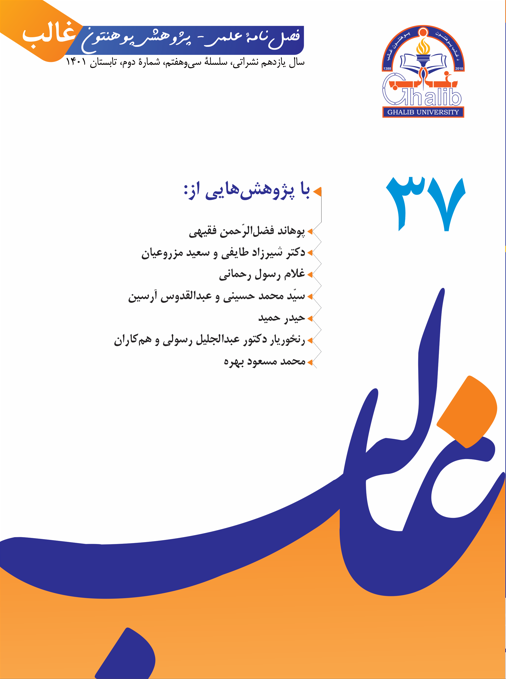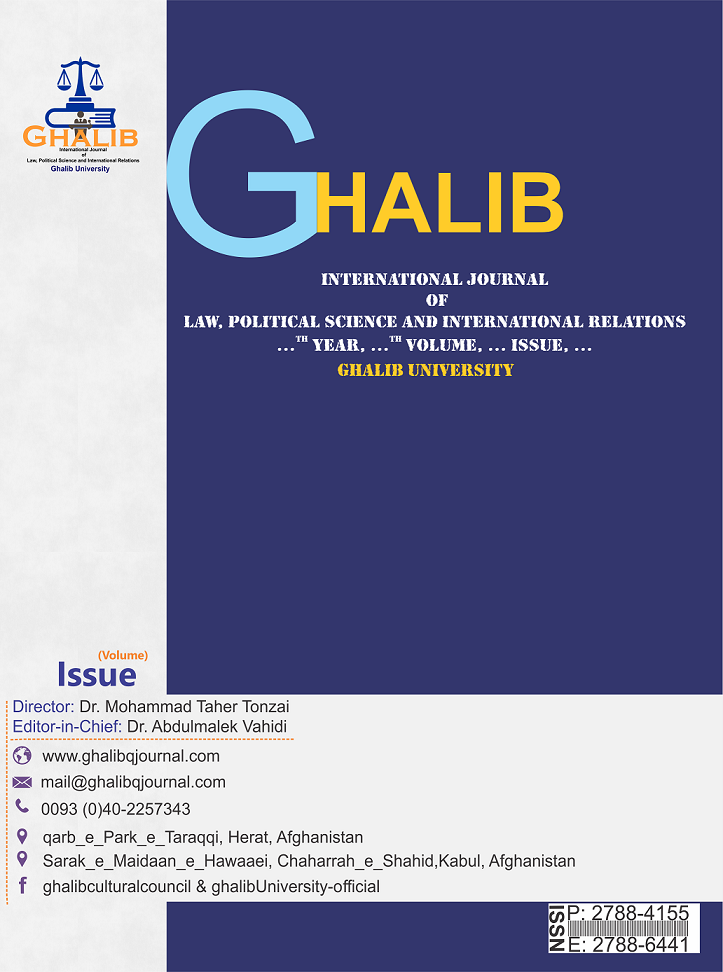Ghazals in praise of the poets of the Talfiq period with an emphasis on the special use of the pronoun "you" in the position of the Radif
DOI:
https://doi.org/10.58342/.v11i2.66Keywords:
Ghazal, Praise Ghazal, Shoma/you Radif, 15th century, Talfigh periodAbstract
Sanaei is the first person who used the word "Shoma/ you" in the position of the Radif of ghazal. This ghazal has praise themes and it seems that placing the word " Shoma / you " in the place of the Radif is the beginning of an evolution in the trend of Persian ghazal. Without knowing the place of the word "Shoma/you" in the Studying the Trends of Persian ghazal, a significant point will remain hidden from the eyes of researchers; Because we have neglected the most important sign or verbal component of clarification for the transformation of the theme in Persian ghazal. By analyzing the trend of Persian ghazal and tracking the word "shoma/you" in the position of Radif, we will find out when praise ghazals became popular in Persian literature and the word will be known as an enlightening sign for searching for this path. In this research, we have answered the question that in terms of theme, what role did the word "Shoma/you" play in Studying the Trends of Persian ghazal? We have assumed that the mention of "Shoma/you" in the place of Radif is due to the appearance of praise of subject of praise/ beloved in the ghazal and the reason for the formation of a trend for the introduction of the theme of praise in the ghazal and the common use of this Radif for the praise ghazal of post-Sanai poets. This research has been carried out using a descriptive-analytical method. The research findings show; Although it does not seem certain that the Ghazal with the Radif of "Shoma/you" is a praise of Sana'i; However, considering that Sana'i also used praise themes in his Ghazals, it is not far off to imagine that the 15th century poets borrowed the capacity of this pronoun from Sana'i.
References
ابن حجر العسقلاني، أبو الفضل أحمد بن علي بن محمد بن أحمد. (۱۳۹۲). الدرر الكامنة في أعيان المائة الثامنة. بتحقیق محمد عبد المعيد ضان، المجلد الثانی. الطبعة الثانیة. صیدر آباد: مجلس دائرة المعارف العثمانية.
ابن عربشاه، أبو محمد أحمد بن محمد. (۱۸۱۷). عجائب المقدور في أخبار تيمور. کلکتا: بینا.
استعلامی، محمد. (۱۳۸۲). درس حافظ: نقد و شرح غزلهای خواجه شمسالدین محمد حافظ. ج۱. تهران: سخن.
اوحدی مراغهای، رکنالدین. (۱۳۴۰). دیوان اوحدی مراغی. با تصحیح و مقابله و مقدمة سعید نفیسی. تهران: امیرکبیر.
ایشانی، طاهره. (۱۳۹۲). «سیر غزل مدحی در ادب فارسی (از سنایی تا حافظ)». کهننامۀ ادب پارسی. سال چهارم. شمارۀ سوم. صص ۱ تا ۲۷.
بخارایی، ناصر. (۱۳۵۳). دیوان ناصر بخارایی. با مقدمه و شرح احوال و حواشی به کوشش مهدی درخشان. تهران: انتشارات بنیاد نیکوکاری نوریانی.
حافظ شیرازی، خواجه شمسالدین محمد. (۱۳۸۷). دیوان حافظ. به تصحیح محمد قدسی. با مقابلۀ چهار نسخۀ چاپی معتبر قزوینی، خانلری، سایه و نیساری. به کوشش حسن ذوالفقاری و ابوالفضل علیمحمدی. تهران: چشمه.
ـــــــــــــــــــــــــــــــــــ . (۱۳۷۵). حافظ به سعی سایه. تهران: نشر کارنامه.
حیدری، علی و مهرنوش دژم. (۱۳۹۲). «جایگاه تخلص در غزلهای مدحی حافظ». مجلۀ شعرپژوهی(بوستان ادب) دانشگاه شیراز. سال پنجم. شمارۀ چهارم. زمستان ۱۳۹۲. پیاپی ۱۸.
خواجوی کرمانی، کمالالدین ابوالعطاء محمود بن علی بن محمود. (۱۳۶۹). دیوان اشعار خواجوی کرمانی. به تصحیح احمد سهیلی خوانساری. تهران: پاژنگ.
سلمان ساوجی، خواجه جمالالدین محمد. (1371). دیوان سلمان ساوجی. با مقدمه و تصحیح زندهیاد استاد ابوالقاسم حالت. به کوشش احمد کرمی. بیجا: سلسله نشریات ما.
سمرقندی، دولتشاه ابن علاءالدوله بختیشاه الغازی. (۱۳۸۲). «تذکرة الشعراء». به سعی و اهتمام و تصحیح ادوارد براون. تهران: اساطیر.
سنایی، مجدود بن آدم. (۱۳۸۰). دیوان حکیم ابوالمجدود بن آدم سنایی غزنوی. با مقدمه و حواشی و فهرست به سعی و اهتمام مدرس رضوی. چ پنجم. تهران: سنایی.
شمیسا، سیروس. (۱۳۷۰). سیر غزل در شعر فارسی. تهران: انتشارات فردوس.
ــــــــــــــ . (۱۳۸۶). معانی. ویراست ۲. تهران: میترا.
ــــــــــــــ . (۱۳۸۸ الف). یادداشتهای حافظ. تهران: نشرعلم.
ــــــــــــــ . (۱۳۸۸ ب). سبکشناسی شعر. چ چهارم. تهران: میترا.
صفا، ذبیحالله. (۱۳۶۹). تاریخ ادبیات در ایران. ج سوم. بخش دوم. تهران: انتشارات فردوس.
عمادالدین فقیه کرمانی، علی. (۱۳۴۸). دیوان اشعار. به تصحیح رکنالدین همایونفرخ. تهران: ابن سینا.
غنی، قاسم. (۱۳۸۶). بحث در آثار و افکار و احوال حافظ. مقدمه به قلم محمد قزوینی. تهران: هرمس.
مالمیر، تیمور و فاطمه محمدخانی. (۱۳۹۱). «نقد و بررسی مدیحهسرایی حافظ». فصلنامۀ متنپژوهی ادبی. ش ۵۱.
مجتبایی، فتحالله. (۱۳۵۲). شهر زیبای افلاطون و آرمان شهریاری ایران باستان. تهران: انتشارات انجمن فرهنگ ایران باستان.
نعمانی، شبلی. (۱۳۶۳). شعر العجم یا تاریخ شعرا و ادبیات ایران (1 و 2). ترجمۀ محمدتقی فخر داعی گیلانی. چ دوم. تهران: دنیای کتاب.
Downloads
Published
How to Cite
Issue
Section
License

This work is licensed under a Creative Commons Attribution-NonCommercial-NoDerivatives 4.0 International License.













